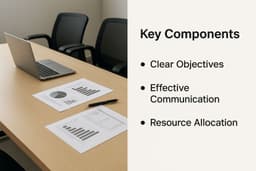Let’s be real for a moment: most meeting minutes are completely useless. They’re where good ideas and critical decisions go to die, buried in a document that no one ever looks at again. Team members are left scratching their heads, wondering what was actually supposed to happen next.
The fix? It’s simpler than you think. You need a meeting minutes format with action items. This one change turns your notes from a passive, historical record into a powerful tool that actually drives work forward.
Why Most Meeting Minutes Fail

We’ve all been in that meeting—the one that feels super productive at the moment, only for everyone to forget who was doing what by the next day. This isn't just a small frustration; it's a massive productivity killer.
Consider this: in the United States alone, somewhere between 36 and 56 million meetings happen every single day. The cost of the bad ones is staggering, estimated to drain the economy of around $37 billion annually. One study even found that employees waste about 91 minutes per day on pointless meetings and tasks. That's a huge gap where real work could be happening.
The root of the problem is usually the way we write minutes. They’re often structured like a novel, recounting every twist and turn of the conversation instead of giving a clear, actionable plan.
The Tell-Tale Signs of Bad Minutes
You can spot ineffective meeting minutes from a mile away. They almost always have a few of these classic momentum-killers.
- No Clear Owner: The notes say something like, "The team will look into new software." Who on the team? Without a name, it's nobody's job.
- Vague "Action Items": You'll see tasks like "Research new marketing strategies." What does that even mean? What's the goal of the research? It’s too fuzzy to be useful.
- Missing Deadlines: An action item without a due date isn't an action item; it's a suggestion. It will inevitably be pushed aside for more urgent work.
- All Talk, No Decisions: The minutes read like a transcript of the conversation, capturing every side-bar and debate but burying the final decisions. Good luck finding what was actually agreed upon.
Switching to a format that puts action first is a strategic move. To dig deeper into this, check out these effective meeting minutes best practices. You can also find more practical advice in our guide on meeting minutes best practices and tips for perfect records.
What Great Meeting Minutes Actually Look Like
Let's be honest: no one wants to read a novel-length recap of a meeting. The best meeting minutes aren't a word-for-word transcript; they're a blueprint for what comes next. If you want people to actually read and act on your notes, you need a lean, scannable format built on three core pillars.
First, you need a quick summary of the key discussions. This isn't the place for every tangent and side comment. Just hit the high points that led to the decisions. Think of it as the "why" behind the "what."
Next, you need a dedicated Decisions Made section. This is where you get brutally clear. No ambiguity, no wiggle room—just a straightforward record of what the team officially agreed to do.
Don't Confuse the Conversation with the Conclusion
This is where most people go wrong. They mash the discussion and the decision together into one big paragraph, which just creates confusion. You have to keep them separate. The discussion gives context; the decision is the final, concrete outcome.
For instance, a discussion summary might look like this: “The team went back and forth on launching the marketing campaign in Q3 versus Q4. We talked about how Q3 would be tight on resources, but a Q4 launch could mean we miss the big holiday sales rush.”
The resulting decision is short and to the point: “Decision: The new marketing campaign will launch on October 15th to capitalize on the holiday sales cycle.”
See the difference? One explains the journey, the other defines the destination. This simple separation is a game-changer for accountability.
This visual shows how to lay out your minutes to focus on what matters most: outcomes.
The Action Items Table: Your Productivity Engine
Now for the most important part. The Action Items table is what turns a conversation into real-world progress. Without it, even the best decisions just sit there, waiting for someone to do something. It's shocking how often this gets missed. A Global Meeting Survey found that only 65% of professionals consistently take meeting minutes, usually because they don't have a simple system in place. You can learn more about why standardized meeting minute practices are so crucial.
To make this work, every action item needs an owner and a deadline. It's the only way to create true accountability.
Here’s a quick look at the essential fields that turn your meeting notes into a powerful tool.
Key Components for Actionable Meeting Minutes
| Component | What It Does | Pro Tip |
|---|---|---|
| Action Item | A specific, clear task that needs to be completed. | Use action verbs like "Draft," "Finalize," or "Research." Avoid vague descriptions. |
| Owner | The single person responsible for getting the task done. | Never assign an action to a whole team. One name creates clear accountability. |
| Due Date | A firm deadline for when the task must be completed. | A specific date (Sep 20) is always better than a vague timeframe ("next week"). |
| Status | A simple way to track progress (e.g., Not Started, In Progress, Done). | This makes your follow-up meetings incredibly efficient. You can see what's stuck at a glance. |
This table is your single source of truth for who is doing what and by when. It's not just a to-do list; it’s a public commitment made by the team.
Let's see how this looks in practice, translating that "October 15th launch" decision into tangible tasks:
| Action Item | Owner | Due Date |
|---|---|---|
| Finalize campaign budget proposal for review. | David Chen | Sep 15 |
| Draft initial ad copy for social media platforms. | Maria Rodriguez | Sep 20 |
| Create a project timeline in Asana and share it with the team. | Sarah Jenkins | Sep 18 |
This structure moves the entire team’s focus from "what we talked about" to "what we're going to do." And that, right there, is the entire point of a productive meeting.
Your Secret Weapon: A Reusable Minutes Template

If you want to create meeting minutes that people actually use, consistency is everything. A go-to template takes the guesswork out of the equation. It guarantees you capture the right information every single time, turning a chaotic scramble into a simple, repeatable process.
The best part? A solid template isn't rigid. It's a flexible foundation you can tweak for any situation, from a quick daily stand-up to a formal quarterly review. Let's walk through building a simple, effective structure you can use in Google Docs, Word, or whatever tool you prefer.
Start with the Basics
Every effective meeting minutes format with action items begins with the essentials. This information gives immediate context to anyone reading the notes later, especially those who couldn't make it. It's the "who, what, when, and why" of your meeting.
Your template should always have a header with these key details:
- Meeting Title: Be specific. "Q4 Marketing Campaign Kickoff" is much better than "Marketing Meeting."
- Date & Time: The exact date and time the meeting happened.
- Attendees: A list of everyone present. It’s also smart to note any key people who were absent.
- Meeting Goal: A single, clear sentence explaining the purpose. For example: "To finalize the project timeline and assign initial tasks."
This simple header makes the document instantly understandable and searchable. No more digging through three different "Project Update" documents to find that one critical decision.
From this foundation, you'll add the sections that drive the work forward: discussion summaries, key decisions, and, of course, the action items. A strong template ensures nothing falls through the cracks. For a closer look at what separates a good template from a great one, check out this guide on creating a meeting action items template that actually works.
Tailor the Template to the Meeting Type
A one-size-fits-all approach just doesn't work. The needs of a rapid-fire team huddle are completely different from a formal board meeting. The trick is to adapt your core structure.
Think about these common scenarios:
- The Daily Stand-Up: Keep it lean. You might only need sections for "Yesterday's Progress," "Today's Plan," and "Roadblocks." Action items are usually quick and direct, like "Owner: Maria, Action: Follow up with the design team on mockups."
- The Project Kickoff: This needs much more detail. Add dedicated sections for "Project Scope," "Key Milestones," "Identified Risks," and "Budget Overview." The action items here will be bigger, defining the very first steps of the project.
- The Brainstorming Session: Here, the focus is on capturing raw ideas. You could have sections like "Ideas Generated" and "Potential Avenues for Exploration." The action items are often about validation, like "Owner: David, Action: Investigate the feasibility of Idea A by EOD Friday."
A few simple formatting tricks can make a world of difference. Always use bold text for task owners so their names jump off the page. In your action item table, a simple color-coding system—like green for 'Done' and yellow for 'In Progress'—gives everyone an instant visual status update at the start of the next meeting.
How to Capture Minutes and Actions Live
Trying to take notes during a live meeting can feel like drinking from a firehose. The conversation moves fast, ideas are flying, and before you know it, you’re completely lost, trying to write down every single word.
The secret? Stop trying to be a court reporter. Your job is to be a strategic listener.
You're not there to transcribe the conversation. You're there to capture the outcomes—the key decisions made and the tasks that need to get done. Shifting your mindset this way is probably the most important skill for anyone using a meeting minutes format with action items.
Listen for Trigger Phrases
A great way to do this is to train your ear to perk up when you hear certain "trigger phrases." These are verbal cues that signal a decision is being made or a task is being assigned. When you hear one, that’s your signal to start typing.
Listen for things like:
- "So, we've agreed that..."
- "The next step is..."
- "Who can take the lead on...?"
- "Let's decide on..."
- "We need to figure out..."
These are your shortcuts. When a colleague says, "Okay, the next step is for me to draft the proposal," you can ignore the five minutes of debate that led to that point. You just need to capture the action itself.
This is especially crucial for longer sessions. Since meetings of three days made up 27.4% of all meetings over a nearly 20-year period, being able to cut through the noise is a must. You can find more details on this in the full report on effective meeting documentation.
Don't Be Afraid to Interject Politely
One of the biggest mistakes I see people make is staying completely silent, even when things are unclear. If a new action item sounds vague, it’s a thousand times better to ask for clarity right then and there than to hunt people down for answers after the meeting.
You don’t have to derail the whole conversation. Just have a few polite phrases ready to go.
For instance, if someone just says, "I'll handle the client outreach," that's not specific enough to be a useful action item. A quick, helpful question can solve this on the spot:
- "Just so I capture this correctly, Sarah, you'll own that? What's a good deadline for the initial outreach?"
- "To make sure this is clear for the minutes, what's the specific outcome we're looking for from that client outreach?"
This little bit of proactive questioning gets you all the details you need—the owner, the specific task, and the deadline—before the group moves on to the next topic. It ensures your action item table is actually useful and prevents that dreaded post-meeting chaos of ambiguous tasks. For more ideas on this, check out our guide on how to take better meeting notes.
Choosing the Right Tools for the Job
While a simple document gets the job done, the right software can turn your meeting minutes from a static record into a living, breathing productivity tool. The best choice really depends on your team's size, budget, and how you already work. The goal is to find something that makes capturing and tracking tasks easier, not just another piece of software to manage.
Let's walk through the three main types of tools I see teams using successfully.
Collaborative Docs for Simplicity
Honestly, for many small teams or straightforward projects, you don't need to overcomplicate things. Tools you already use, like Google Docs or Microsoft Word Online, are often the perfect starting point.
They're familiar, free, and everyone knows how to use them. You can drop the template from earlier into a doc, share the link, and you’re good to go. People can see updates as they happen, and the built-in version history is a great safety net. The only real catch is that the action items exist in a vacuum, meaning you have to manually transfer them or follow up to see what’s getting done.
Project Management Platforms for Integration
This is where your meeting minutes start to feel truly powerful. When you use a platform like Asana, Trello, or Monday.com, you can connect your notes directly to your actual work.
Think about it: during a project check-in, you identify a new task for the design team. Instead of just jotting it down, you create a task right there from your notes, assign it to Sarah, and pop in a due date. That action item is now part of the project's workflow, where it will generate notifications and can be tracked by everyone. This completely closes the loop between discussion and execution.
AI Meeting Assistants for Automation
The newest tools on the block are AI meeting assistants, and they're a game-changer for people who hate taking notes. Tools like Otter.ai or Fireflies.ai can join your virtual meetings and automatically transcribe the entire conversation.
After the meeting, they can generate summaries, pull out key decisions, and even suggest action items. It's a huge time-saver. You can use AI-powered meeting summaries to improve productivity to make sure every decision and task gets captured without you having to type frantically. The only trade-off is that you’ll probably still want to give the summary a quick human review for nuance and context, but it gives you an incredible head start.
Comparing Tools for Meeting Minutes
Your team's needs will determine the best tool. Here’s a look at how the main options compare.
| Tool Type | Best For | Pros | Cons |
|---|---|---|---|
| Collaborative Docs | Small teams, simple projects, or getting started with a low budget. | - No cost - Easy to use; no training needed - Real-time collaboration | - Action items are disconnected from work - Requires manual follow-up - Can get messy |
| Project Mgt. Platforms | Teams that need to connect meeting outcomes directly to project tasks. | - Creates accountability - Integrates notes with workflows - Centralizes all project info | - Can be expensive - Requires setup and team buy-in - Might be overkill for simple meetings |
| AI Meeting Assistants | Teams with many virtual meetings who want to automate note-taking. | - Saves significant time - Provides full transcripts - Automatically identifies key items | - Transcription isn't always 100% accurate - May miss nuanced context - Often requires a subscription |
Ultimately, there's no single "best" tool—only the one that fits seamlessly into your team's process and makes follow-through happen.
Common Questions (and Expert Answers) About Meeting Minutes
Even with a great template in hand, you’ll inevitably run into a few questions once you start putting it all into practice. Let's tackle some of the most common hurdles I've seen teams face when trying to master meeting minutes with action items.
Getting these details right is what makes your minutes a genuinely useful tool instead of just another document that gets filed away and forgotten.


